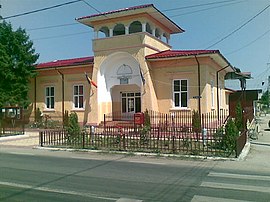
The Vedea is a river in southern Romania that flows from the Cotmeana Plateau and empties into the Danube. It has a total length of 224 km, of which 33 km is regulated. Its drainage basin area is 5,430 km2.

Teleorman County is a county (județ) of Romania on the border with Bulgaria, in the historical region Muntenia, with its capital city at Alexandria.
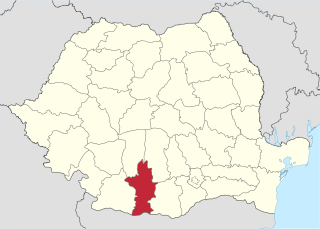
Olt County is a county (județ) of Romania on the border with Bulgaria, in the historical regions of Oltenia and Muntenia. The capital city is Slatina.

Argeș County is a county (județ) of Romania, in Muntenia, with the capital city at Pitești.

Videle is a town in Teleorman County, Muntenia, Romania, with a population of 10,107 in 2021. It was upgraded to town status in 1968 by incorporation of a few villages nearby. Today, Coșoaia is the single associated village the town administers.

Roșiorii de Vede is a city in Teleorman County, Romania. Located in the Muntenia region, it is one of the oldest cities in the country. It was first mentioned in a document which dates back to 1385, when the city was visited by two German pilgrims who were returning from Jerusalem and stopped for a few days in a town they called Russenart.
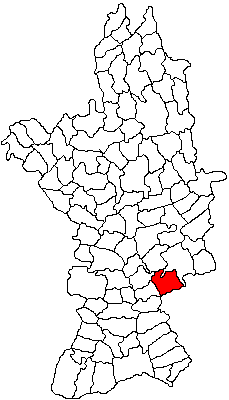
Sprâncenata is a commune in Olt County, Muntenia, Romania.
Siliștea may refer to several places in Romania:
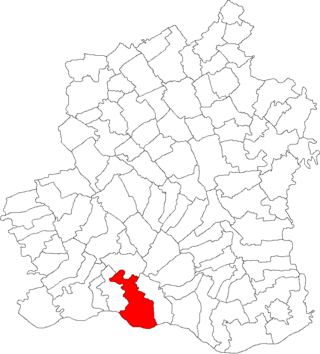
Seaca is a commune in Teleorman County, Muntenia, Romania, about 15 km east of Turnu Măgurele and 10 km north of the Danube River. Its population is about 2,500 people. It is composed of two villages, Năvodari and Seaca. The majority of people speak Romanian, with some speaking a form of the Romani language. A sizable part of the residents are landowners. The main crops planted are grains such as wheat, corn, and to a smaller degree rice. A smaller percentage of the residents work in nearby cities, mainly in Turnu Măgurele and to a lesser degree in Alexandria.

Islaz is a commune in southern Romania, located in the southwestern Teleorman County, 10 km (6.2 mi) west of Turnu Măgurele. It is part of the historical province Oltenia, and is composed of two villages, Islaz and Moldoveni.
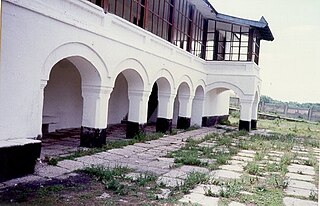
Ștorobăneasa is a commune in the southern part of Teleorman County, Muntenia, Romania, on the left side of the Teleorman River. The commune has 3,101 inhabitants and a surface of 352.8 ha within the built-up area. It is composed of two villages, Beiu and Ștorobăneasa.
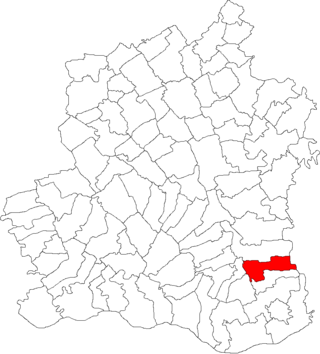
Cervenia is a commune in the southern part of Teleorman County, Muntenia, Romania, on the left (east) bank of the river Vedea, 22 km southeast from Alexandria. It is composed of a single village, Cervenia.

Băbăița is a commune in Teleorman County, Muntenia, Romania. It is composed of two villages, Băbăița and Merișani. It included two other villages until 2004, when they were split off to form Frăsinet Commune.

Poroschia is a commune in Teleorman County, Muntenia, Romania. It is composed of two villages, Calomfirești and Poroschia.

Talpa is a commune in Teleorman County, Muntenia, Romania. It is composed of five villages: Linia Costii, Rotărești, Talpa-Bâscoveni, Talpa-Ogrăzile, and Talpa Poștei.

Tătărăștii de Sus is a commune in Teleorman County, Muntenia, Romania. It is composed of three villages: Dobreni, Tătărăștii de Sus, and Udupu.
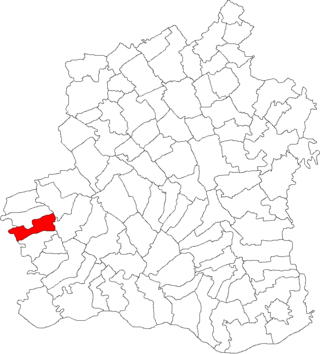
Slobozia Mândra is a commune in Teleorman County, Muntenia, Romania. It is composed of a single village, Slobozia Mândra. It also included two other villages until 2004, when they were split off to form Uda-Clocociov Commune.
Găujani is a commune located in Giurgiu County, Muntenia, Romania. It is composed of three villages: Cetățuia, Găujani, and Pietrișu.

Izbiceni is a commune in Olt County, Oltenia, Romania. It is composed of a single village, Izbiceni.

The Helmet of Peretu is a Geto-Dacian silver helmet dating from the 4th century BC, housed in the National Museum of Romanian History, Bucharest. It comes from Peretu area, in the Teleorman County, Romania. There were 50 artifacts having 750g. The helmet is similar to the Helmet of Coţofeneşti and other three Getian gold or silver helmets discovered so far.
